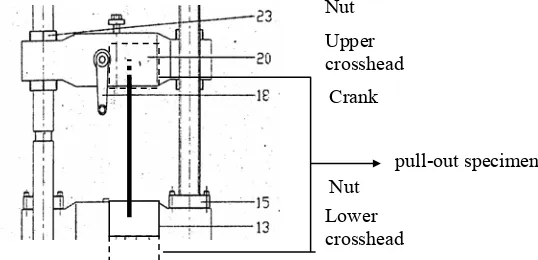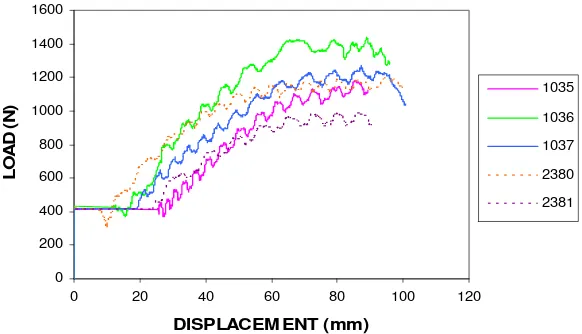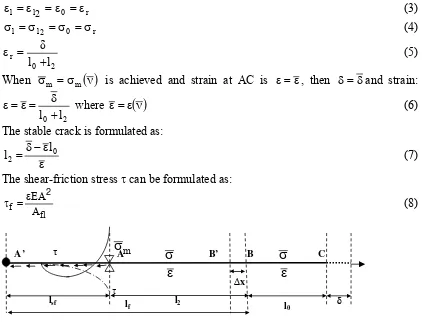WITH CLUMPED FIBER END
Rr. M.I. Retno Susilorini1
1Lecturer, Civill Engineering Study Program, Faculty of Engineering, Soegijapranata Catholic
University, Jl. Pawiyatan Luhur IV/1, Bendan Dhuwur, Semarang, Telp 024-8441555, email: [email protected]; [email protected]
Fiber pull-out modeling is engaged to bond mechanism of the interface between fiber and cementitious matrix. Hereby, the bond interface takes an important role in determining the whole composites structure performance. When a slippery fiber of nylon 600 is applied into “fiber-reinforced cementitious composite” (FRCC), then the bond interface mechanism should be increased to reach a better performance of whole composites. The clumped fiber end condition indicates some performance improvements, rather than the straight one. Advancement of the previous Susilorini’s model of fiber pull-out with clumped embedded fiber end will show that shear-friction stress τ takes major contribution in modeling of nylon 600 with clumped fiber end. The pull-out process involved stable fracture and unstable processed that are being specific interest in this research. The research delivers experimental and analytical methods. The experimental method conducts pull-out test with pull-out specimens categorized into specimens with straight fiber end and also specimens with clump fiber end. The fiber is nylon 600 made in Indonesia, diameter of 1.1 mm, and fiber embedded length lf of 100 mm. A computerized closed-loop universal testing machine is going to be
precise equipment measuring the load and displacement of specimens during the pull-out test. The analytical method is modeling the fiber pull-out with clumped fiber end and resulting some formulas and theories for the process of fiber pull-out with clumped fiber end. The experimental results show that specimens with clumped fiber end reach loads about 1200-1400 N that are 14-35% higher that specimens with straight fiber end while the maximum displacement of those specimens reach around 100 mm. The analytical method successfully results the fiber pull-out with clumped fiber end model, and meet a finding of formulas and theories. The model of fiber pull-out with clumped fiber end model fit the experimental results. It is also found that maximum shear-friction stress τ valued as 2.775 MPa with parabolic curve of shear-friction τ and displacement δ relationship. This research meets several theories which are new, specific and significant, they are: (a) The clumped embedded fiber end condition generates parabolic curve of shear-friction stress τ and displacement relationship; (b) shear-friction τ is emerged to against the fiber tension load; (c) The higher bond capacity σm is, the higher shear-friction stress τ will be; (d) The length of stable crack is determined by the position of crack arrester; (e) A new equation derived for load Pn for a model for fiber pull-out
of nylon 600 with clumped embedded fiber end which is involves the shear-friction stress τ; and (f) The clumped embedded fiber end improves the pull-out load of nylon 600 fiber pull-out specimens.
Keywords: model, pull-out, nylon 600, shear-friction, clumped fiber end
1.
INTRODUCTION
takes an important role in determining whole “fiber-reinforced cementitious composite” (FRCC) performance.
The application of synthetic fiber into FRCC is believed becomes advantage in improving it performance. Nylon fiber is a good example of success effort to reach great tensile ductility of FRCC. One to be noted, nylon fibers is unique as mentioned by [9]. During stretching condition, nylon fiber constricts many times and perform two moving surface waves along the fiber length. This phenomenon is called ‘yield point elongation’ that has magnitude of 200%-300% of initial fiber length. Later, because of the nylon viscosity, the load may gradually decrease while the fiber length becomes longer two or three times. The multiple constrictions of nylon fiber appeared by ‘jagged’ phenomenon of stress-strain or load-displacement curves.
Same similar ‘jagged’ phenomenon happened with mild steel [9], aluminium alloy [9], and nylon [10] and [1]. The application of local (Indonesia) made nylon fiber for concrete has established by previous researches [11], [12], and [1]. The research of [11], [12] used flexural beam and cylinder fiber concrete specimens with straight and clumped short fibers and found that flexural and splitting tensile strength of nylon fiber concrete is higher than the plain concrete. It was also investigated by [11], [12], that wider crack width is found on plain concrete. The research of [1] established pull-out model using pull-pull-out and fracture specimens with straight fibers that established many theories of unstable and stable cracks, the presence of crack arrester, equations for bond capacity σm and Poisson’s ration of fiber relation, fiber stress σs and matrix
stress σm relation at the time of failure, stable crack length, load for pull-out and
fracture pull-out models, determination of bond capacity by using stable crack, existing of slip stage and strain-hardening stage, and also the possibility of crack arrester presence.
Significant effort in determining the bond mechanism between fiber and cementitious matrix deliver a deep review of fiber pull-out modeling. In FRC, the interface between fiber and matrix behaviour and performance will be predicted by pull out tests. While the tensile ductility performance is a must, the using of synthetic fibers in FRC obviously presents added values, that are strain-hardening property [1], higher tension strength, elastic modulus, and various fiber surfaces [6], high performance as alike steel performance [7], and even higher compressive stress for fiber concrete that its nylon fibers are irradiated by gamma [8].
Fiber pull-out modeling is engaged to bond mechanism of the interface between fiber and cementitious matrix. Hereby, the bond interface takes an important role in determining the whole composites structure performance. When a slippery fiber of nylon 600 is applied into FRCC, then the bond interface mechanism should be increased to reach a better performance of whole composites. The clumped fiber end condition indicates some performance improvements, rather than the straight one.
2.
METHODS OF RESEARCH
The research delivers experimental and analytical methods. The experimental method conducts pull-out test with pull-out specimens described by Figure 1, categorized into specimens with straight fiber end and also specimens with clump fiber end. The clumped embedded fiber end condition was made by burning the end of fiber until the fiber end change into clumped form. The fiber is nylon 600 made in Indonesia, diameter of 1.1 mm, and fiber embedded length lf of 100 mm. Mix design for
cementitious matrix is defined as ratio of cement : sand : water as 1:1:0.6. A computerized closed-loop universal testing machine is going to be precise equipment measuring the load and displacement of specimens during the out test. The pull-out test set-up is described by Figure 2.
specimen width = 20 mm
fixed part length, 150 mm
70 mm
specimen length, l1 = 250 mm
fixed part length, 150 mm fiber outer length, 30 mm
embedded length, 100 mm
clumped embedded fiber end
Figure 1. Dimensions of Pull-Out Specimen with Clumped Embedded Fiber End
Nut
pull-out specimen
Lower crosshead Upper
Crank
Nut crosshead
Figure 2. Pull-Out Test Set-Up
3.
RESULTS, MODELING, AND DISCUSSION
3.1.Results
0 200 400 600 800 1000 1200 1400 1600
0 20 40 60 80 100 120
DISPLACEM ENT (mm)
L
O
AD (
N)
1035
1036
1037
2380
2381
Figure 3. Load-displacement Relation of Pull-Out Test with Straight and Clumped Fiber End
It is found by experimental result that nylon fiber has had average maximum tension stress of 1471.21 MPa, average maximum strain of 0.89, average maximum elongation of 84.11%, and average maximum tension load of 1398.13 N.
Obviously, the ‘jagged’ phenomenon performs on the relation of load-displacement (P-δ) and stress-strain (σ−ε) curves. For critical Poisson’s ratio of fiber ofν=0.47, the critical strain of nylon will reachε=0.29. The experimental results noted that out specimens with straight and clumped fiber end perform several stages of pull-out process (Figure 3): (a) Pre-slip stage, (b) slip stage, and (c) Strain-hardening stage.
The pull-out test results with straight fiber end found pre-slip loads are about 400-430 N and pre-slip displacements of no more than 0.1 mm. The slip loads have been found in the same range of pre-slip loads with displacements of 3-30 mm. The strain-hardening loads are observed as 900-1200 N as regard. For pull-out test results with clumped fiber end, the pre-slip loads are ranged about 400-430 N with pre-slip displacements of no more than 0.1 mm. The slip loads had the same range of pre-slip loads with displacements of 3-30 mm while strain-hardening loads are about 1200-1400 N and displacement of 20-100 mm. It is also fond that the pre-slip stress are ranged about 400-460 MPa with pre-slip strain of no more than 0.001. The slip stress had the same range of pre-slip loads with strain of 0.001-0.155, while strain-hardening loads are ranged about 1400-1500 MPa and strain of 0.15-0.9.
3.2.Modeling
exists on strain-hardening part of load-displacement (P-δ) and stress-strain (σ−ε) curves of pull-out, (4) Unstable and stable fracture process phenomenon exist during the pull-out process, and (5) Shear-friction τ is emerged to against the fiber tension load.
A B C
l0 δ
lf
σm
σ1 ε1
A’
τ τ
Figure 4. Pull-Out Model with Clumped Embedded Fiber End at Elastic Stage
Figure 4 describes the first principal thought of the model. A piece of embedded fiber (A’A) with clumped embedded fiber end at A’ which is constrained at A and B but free at C. Free end fiber length named l0 and embedded fiber end called lf. A
displacement δ is applied at C and both cementitious matrix and fiber are still in composites condition. The force resistance of clumped fiber end will emerge shear-friction stress τ that is distributed along the fiber-matrix interface. The value of matrix stress σm increases until σm =σm =σm
( )
ν which represents bond capacity at the timeof crack. It is called the ultimate fracture tension capacity. The strain and stress at BC:
0 1
l δ =
ε (1)
s 1 1 =ε E
σ (2)
A
B C
l2 l0 δ
lf
m
σ
σ
ε
σ
ε
A’
τ τ
lsf
Figure 5. Pull-Out Model with Clumped Embedded Fiber End atUnstable Fracture Process
A crack will be created when the displacement δ keeps growing. This crack performs unstable fracture process. After a crack created, the stress of the composite then being transferred to the fiber. By crack formation, unstable fracture process phenomenon will release the constraint at B (Figure 5). The crack length is growing to be as long as l2 and constraint at A still can remove to left side. When the crack length l2 is longer
than embedded length lf, fiber may be pulled-out. The shear-friction stress τ is then
distributed along A’A. The length of shear-friction stress τ distribution is called lsf. It
An unstable fracture process may grow into stable fracture process which. Assume that a crack formed as (Figure 6), then the increasing of displacement δ will also increase strain ε1 and stress σ1 at B’B. Those strain ε1 and stress σ1 increasing will
cause the achieving critical value of matrix stress σm and strainε. Therefore, the displacement δ increasing repeated at B’ at the same time a new crack of another formed Δx at the left side of fiber. During the crack Δx formation, the shear-friction stress τ gives contribution along the embedded fiber to against the displacement of fiber free-end. It happened continuously until constraint A is fixed. Hence, the constraint A becomes ‘crack arrester’ that will prevent crack growth. In case, the crack will be stopped to grow and crack length remains l2. Once stable crack length l2
achieved, then strain at l0 part transfer to l2 part. The stress and strain become:
r
The stable crack is formulated as:
ε
The shear-friction stress τ can beformulated as:
fl
Figure 6. Pull-Out Model with Clumped Embedded Fiber End atStable Fracture Process
The model represents a P-δ (load-displacement) curve (Figure 7) that consists of 3 (three) stages of pull-out process: (a) Stage of pre-slip, (2) Stage of slip, and (3) Stage of strain-hardening. During the stage of pre-slip, cracks have not been created, so that the fracture process phenomenon not exists. After critical matrix stress σm exceeded, a crack is formed, the stage of slip and unstable fracture process has just begun. The unstable fracture process keeps going and crack length increases until stable crack length l2 reached at the end of stage of slip. The stable crack length l2 will be achieved
stress τ that is distributed along the embedded fiber. Obviously, the shear-friction stress τ will against the fiber tension load and improve the specimen’s pull-out load. .
P
Pps
δ
pre-slip strain-hardening Ps
Figure 7. P-δ (load-displacement) Relation of Theoretical Pull-Out Model
Formulation of the theoretical model is defined by equation (9) as follow:
f of strain hardening. The range value of E
25
<2000. The theoretical model above has compared to experimental results. The P-δ (load-displacement) curves and σ-ε (fiber stress-strain) curve of experimental result and model (Figure 8 and 9) and also the τf-ε (shear-friction stress-strain) curve of
0
Figure 8. Load-displacement Relation of Experimental Result and Model
0
Figure 9. Stress-strain Relation of Experimental Result and Model
0.00
Figure 10. Shear-friction stress-strain Relation of Experimental Result and Model
The research has proved that the ‘jagged’ phenomenon performs on the relation of load-displacement (P-δ) and stress-strain (σ−ε) curves because of the nylon unique characteristics of constriction and viscosity. This phenomenon cannot be found with any other fiber materials (except mild steel and aluminium alloy). The stages of pull-out process (stage of pre-slip, stage of slip, and stage of strain-hardening) performs strong character of unstable and stable fracture phenomenon.
Figure 8 and 9 show that the model fit to the experimental results. The maximum strain of both model and experimental results (0.8) are lower than maximum strain of nylon fiber tension test (0.89). It is found that the pull-out load of clumped fiber end specimens is 14-35% higher than the pull-out load of straight embedded fiber end specimens (Figure 3). The reason of lower strain and the pull-out load improvement is because of the clumped embedded fiber end condition generates higher shear-friction stress τ to against the fiber tension load will improve the specimen’s pull-out load.
It should be noted that the clumped embedded fiber end condition will emerge higher shear-friction stress τ that is distributed along the embedded fiber to against the displacement of fiber free-end. The parabolic curve of shear-friction stress τ and displacement relation emphasizes that the higher bond capacity σm is, the higher shear-friction stress τ will be.
4.
CONSLUSIONS
This research meets several theories, which are new, specific and significant, they are: (a) The clumped embedded fiber end condition generates parabolic curve of
shear-friction stress τ and displacement relationship;
(b) shear-friction τ is emerged to against the fiber tension load;
(c) The higher bond capacity σm is, the higher shear-friction stress τ will be; (d) The length of stable crack is determined by the position of crack arrester; (e) A new equation derived for load Pn for a model for fiber pull-out of nylon
600 with clumped embedded fiber end which is involves the shear-friction stress τ;
(f) The clumped embedded fiber end improves the pull-out load of nylon 600 fiber pull-out specimens
ACKNOWLEDGMENT:
The authors gratefully acknowledge UBCHEA (United Board of Higher Christian Education) for supporting the research grant (2005-2007), Prof. Ir. Moh. Sahari Besari, MSc., PhD., and Prof. Bambang Suryoatmono, PhD., for their great contributions of ideas, discussions, and intensive assistance.
NOTATION
A fiber section area (mm2) Afl fiber surface area (mm2)
D fiber diameter (mm)
Epr modulus of elasticity at stage of strain-hardening (MPa)
Eps modulus of elasticity at stage of pre-slip (MPa)
Es modulus of elasticity at stage of slip (MPa)
P, Pn tension load (N)
a1 total displacement of a stage (mm)
a2 initial length of specimen or fiber that is specific for every stage (mm)
b specimen width (mm)
rΔI ratio of total free-end fiber displacement of free-end at stage of pre-slip
rΔII ratio of total free-end fiber displacement of free-end at stage of slip
rΔIII ratio of total free-end fiber displacement of free-end at stage of
strain-hardening
l0 initial outer fiber length (mm)
l2 stable crack length (mm)
lf embedded fiber length (mm)
lsf length of shear-friction (mm)
xi relaxation length for n at stage of strain-hardening (mm)
Δi free-end displacement for n at stage of strain-hardening (mm)
σ1 fiber stressat the midldle of right side of matrix (MPa)
2
l
σ fiber stress at l2 part when stable crack length achieved (MPa)
REFERENCES:
1. Susilorini, Retno, M.I. (2007) Model Masalah Cabut-Serat Nylon 600 Tertanam dalam
Matriks Sementitis yang Mengalami Fraktur, Unpublished PhD Dissertation,
Postgraduate Program, Parahyangan Catholic University, Bandung.
2. Susilorini, Retno, Rr. M.I. (2007) Fractured Based Approach for Structural Element Design – Safe Building, Safe City, In: Third International Conference on Economic and Urban Management “City Marketing, Heritage, and Identity”, 24-25 August, PMLP Unika Soegijapranata, Semarang, 451-465.
3. Susilorini, Retno, Rr. M.I. (2007) The Performance Improvement of Fiber Pull-Out of Nylon 600 with Clumped Fiber End, In: First International Conference of European
Asian Civil Engineering Forum (EACEF), 26-27 September, Pelita Harapan
University, Lippo Karawaci, Jakarta, D64-D71.
4. Susilorini, Retno, Rr. M.I. (2007) Integral-J Kritis untuk Model Elemen Hingga pada Cabut Serat Fraktur Nylon 600, In: Tiga Roda Forum “Perkembangan Terkini Teknologi dan Rekayasa Konstruksi Beton di Indonesia”, 12 December, Hotel Bumi Karsa - Bidakara, Jakarta, 1-14.
5. Naaman, AE., Namur, GG., Alwan, JM., Najm, HS. (1990) Fiber Pullout and Bond Slip. I: Analytical Study. Journal of Structural Engineering, ASCE, 117(9), 2769-2790.
7. Clements, M. (2002) Synthetic as Concrete Reinforcement, In: Concrete Magazine, United Kingdom, September, 37-38.
8. Martinez-Barrera, G (2006) Concrete Reinforce with Irradiated Nylon Fibers. Journal of Material Research, 21(2), February, 484-491.
9. Nadai, A. (1950) Theory of Flow and Fracture of Solids. Volume I, McGraw-Hill Company. Inc, New York, USA.
10. Avarett, RD (2004) Fracture Mechanics of High Performance Nylon Fibers, Thesis, Georgia Institute of Technology, USA.
11. Suseno, W., Saptono, K., Yosephine, P., Andre, S. (2000) Pengaruh Fiber Senar Pancing Terhadap Kuat Lentur Beton. Jurnal Sipil Supra, 2(4), April-June, 116-124.





